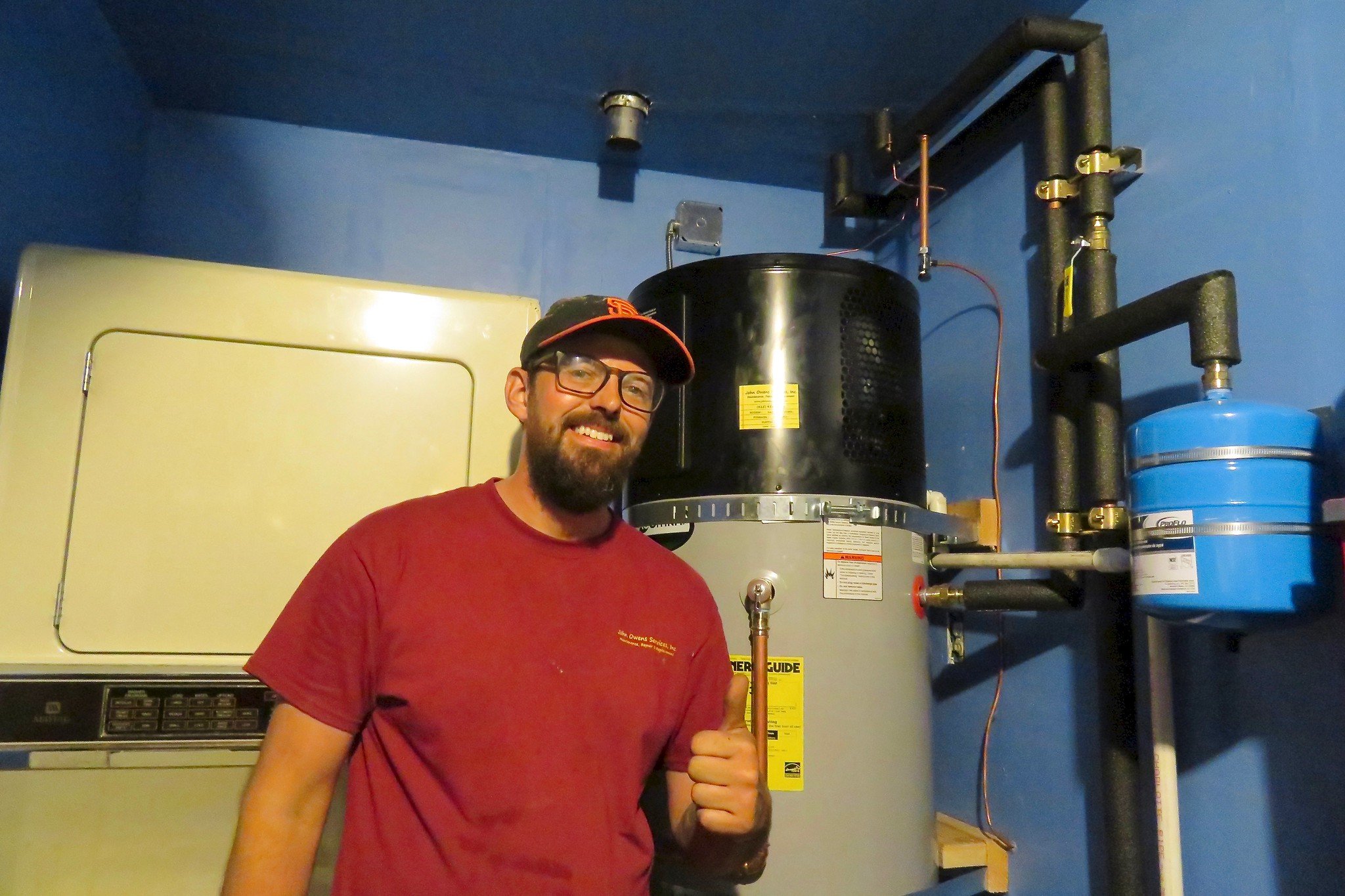All-Electric Buildings Will Help Falls Church Meet Climate Goals
To help a homeowner reduce greenhouse gas emissions, a contractor finishes installing an electric water heater with a heat pump in a California home, replacing an old natural gas water heater. Creative Commons photo by flickr.com/fabola.
by Tim Stevens
An important tool with multiple benefits for reducing greenhouse gas emissions in Falls Church has recently emerged. With City encouragement, developers of several mixed-use projects agreed to build their residential rental units to be all-electric, including appliances, heating, and cooling. The developers of Founder's Row II, Broad and Washington, and the West Falls senior building have committed to all-electric appliances for residents.
The benefit of an all-electric approach is tied to gradually reducing greenhouse gas emissions in electricity production by utilities, mainly by phasing out coal and gas and adding renewable sources such as solar. The trend of adding renewable energy to the grid will accelerate over the next decade as more solar and wind energy projects are added to the grid, thanks to the Virginia Clean Economy Act (VCEA). Alternatively, buildings that install gas appliances would be locked into the emissions released when that gas is burned.
Reducing climate-changing greenhouse gases is difficult for local governments everywhere. State and federal governments control most policy decisions affecting emissions, and until recently, they have been slow to act. Examples of their broad authority are the federal Inflation Reduction Act and the VCEA.
Further adding to the challenge for local governments is Virginia being a Dillon Rule state, which limits local governments’ actions only to what the state General Assembly explicitly approves. For example, it took Fairfax County five years to get state permission to install a solar energy system on a closed county-owned landfill.
Larger nearby jurisdictions, such as Arlington and Montgomery County, have added staff, such as energy managers, to track emissions and implement plans to reduce them. Evidence suggests they have achieved some success. Smaller jurisdictions, such as Falls Church, have taken a lighter touch thus far on implementing actions to reduce emissions. In November, City Council adopted a Community Energy Action Plan and unanimously passed a resolution to elevate its 2050 goal for community greenhouse-gas emissions from an 80% reduction (vs. 2005 levels) to net-zero (100% reduction), which is more in line with the Commonwealth, neighboring jurisdictions, and the global scientific consensus of what is needed.
While buildings that are LEED certified (Leadership in Energy and Environmental Design) are less harmful environmentally than buildings without certification, this doesn't mean that a building's emissions will be in line with what is needed to achieve overall goals. Using natural gas for appliances and indoor temperature control, for example, is allowed by LEED, and is a large source of emissions overall.
Reaching Falls Church’s emissions reduction goals will require significantly lowering buildings’ gas consumption. Existing buildings that use gas will need to convert to electric appliances. Designing new buildings to be all-electric will make the overall task of conversion easier.
Not only will use of electricity result in reduced emissions, but it will also provide other important benefits:
Air Quality | Gas appliances release nitrogen oxides, which add to smog in the atmosphere. The amount of nitrogen oxides from buildings is larger than the amount released from utility power plants using gas to produce electricity.
Health | Much of the gas used in buildings is sourced from underground wells using a process called "fracking." Extracting gas through fracking is an intensive industrial process that stresses the environment. The harms are disproportionately experienced by people living near industrial fracking sites. In addition, burning gas in buildings can also be an irritant to people with asthma.
Safety | Transmitting gas through pipelines creates significant fire and explosion risks. In addition, an estimated 1.4 to 2.3 percent of natural gas leaks at some point in the production and transmission process — starting with wells and the pipelines that carry gas to buildings where it is burned — further harming air quality and releasing climate-altering methane into the atmosphere.
Economics | Many developers like not having to install costly gas pipelines in new buildings.
Historically, gas appliances have appealed to many consumers as offering better performance than their electric counterparts. Recent improvements in electric appliances are starting to change that perspective. Heat pumps, for domestic heating and hot water, have improved significantly in recent years.
Less familiar to consumers are the improvements in electric induction ovens and cooktops. Rather than use slow-reacting heating coils, induction ovens create a magnetic field that sends pulses into cookware. This causes electrons in the cookware to move faster, resulting in heat. The performance is much better and faster than older electric ovens.
Induction ovens involve no open flames, which is safer for all residents, especially children. Cleaning them is also easier since there are no removable grates or burners to clean.
Finally, the Inflation Reduction Act offers many homeowners financial incentives for converting from gas to electric. Learn more about clean energy tax credits for consumers.
Tim Stevens is chair of the City's Planning Commission.
A version of this article appeared in the Falls Church News-Press in November 2022.
